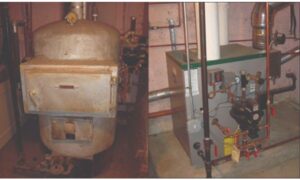With the outgrown pollution and ever-increasing consumption of cooling and refrigeration which is detrimental for the environment, Ammonia refrigeration is said to be the safer with power saving technology for efficient refrigeration.
Ammonia is one of the most popular refrigerants across the globe. It is incredibly efficient and environmentally sustainable for various industrial refrigeration applications. It is basically a chemical consisting of one atom of nitrogen and three atoms of hydrogen, designated as NH3.
Natural refrigerants have been in the spotlight with the gradual phase out of many common synthetic refrigerants since the release of the Montreal Protocol in 1987.
More recently, hydrofluorocarbons (HFCs) and hydrochlorofluorocarbons (HCFCs) have been identified globally as the fastest growing source of greenhouse gas (GHG) emissions. Considering this statistic, refrigerant management has been identified as a top priority for climate solutions.
Below are the top 6 reasons why natural refrigerants are a smart decision when choosing your next industrial refrigeration system.
Whether your refrigeration system is for food processing, cold storage, ice rinks, or anything in between, CO2 and ammonia are viable as natural refrigerant options –
• Both ammonia and CO2 have an ozone depletion potential of zero.
• Ammonia has a Global Warming Potential (GWP) of zero and CO2 has a GWP of one.
• By comparison, HFCs have a GWP in the thousands.
• CO2 and ammonia are both naturally occurring substances.
• Systems that use CO2 and/or ammonia as refrigerants are often much more efficient than those using HFCs and HCFCs.
• Natural refrigerants are typically significantly less expensive than synthetic alternatives.
• GINatural refrigerants are viewed as “future-proof”, meaning that it is unlikely that their use will be significantly limited by legislation.
More recently, hydrofluorocarbons (HFCs) and hydrochlorofluorocarbons (HCFCs) have been identified globally as the fastest growing source of greenhouse gas (GHG) emissions. Considering this statistic, refrigerant management has been identified as a top priority for climate solutions.
Ammonia is extremely soluble in water and is frequently used as a water solution called aqua ammonia. Ammonia chemically combines with water to form ammonium hydroxide. Household ammonia is a diluted water solution containing 5 to 10 percent ammonia. On the other hand, anhydrous ammonia is essentially pure (over 99 percent) ammonia. “Anhydrous” is a Greek word meaning “without water”; therefore, anhydrous ammonia in ammonia without water. Anhydrous ammonia is a clear liquid that boils at a temperature of -28°F. In refrigeration systems, the liquid is stored in closed containers under pressure.
When the pressure is released, the liquid evaporates rapidly, generally forming an invisible vapour or gas. The rapid evaporation causes the temperature of the liquid to drop until it reaches the normal boiling point of -28°F, a similar effect occurs when water evaporates off the skin, thus cooling it. This is why ammonia is used in refrigeration systems.
Refrigerant grade anhydrous ammonia is a clear, colourless liquid or gas, free from visible impurities. It is at least 99.95 percent pure ammonia. Water cannot have a content above 33 parts per million (ppm) and oil cannot have a content above 2 ppm. Preserving the purity of the ammonia is essential to ensure proper function of the refrigeration system.
Anhydrous ammonia is easily absorbed by water. At 68°F, about 700 volumes of vapour can be dissolved in one volume of water to make a solution containing 34 percent ammonia by weight. Ammonia in water solution is called aqua ammonia or ammonium hydroxide.
Ammonia, especially in the presence of moisture, reacts with and corrodes copper, zinc, and many alloys. Only iron, steel, certain rubbers and plastics, and specific nonferrous alloys resistant to ammonia should be used for fabrications of anhydrous ammonia containers, fittings, and piping.
Ammonia will combine with mercury to form a fulminate which is an unstable explosive compound.
Anhydrous ammonia is classified by the Department of Transportation as nonflammable. However, ammonia vapour in high concentrations (16 to 25 percent by weight in air) will burn. It is unlikely that such concentrations will occur except in confined spaces or in the proximity of large spills. The fire hazard from ammonia is increased by the presence of oil or other combustible materials.Liquid anhydrous ammonia weighs less than water. About eight gallons of ammonia weighs the same as five gallons of water.
Liquid and gas ammonia expand and contract with changes in pressure and temperature. For example, if liquid anhydrous ammonia is in a partially filled, closed container it is heated from 0°F to 68°F, the volume of the liquid will increase by about 10 percent. If the tank is 90 percent full at 0°F, it will become 99 percent full at 68°F. At the same time, the pressure in the container will increase from 16 pounds per square inch (psi) to 110 psi.
Liquid ammonia will expand by 850 times when evaporating
Anhydrous ammonia gas is considerably lighter than air and will rise in dry air. However, because of ammonias tremendous affinity for water, it reacts immediately with the humidity in the air and may remain close to the ground.
The odour threshold for ammonia is between 5 – 50 parts per million (ppm) of air. The permissible exposure limit (PEL) is 50 ppm averaged over an 8-hour shift. It is recommended that if an employee can smell it, they ought to back off and determine if they need to be using respiratory protection.
There are some inherent risks when working with ammonia, so it is important to always remain diligent when in the presence of the chemical. It is a very efficient and sustainable refrigerant that is widely used for a variety of refrigeration applications. It is important to recognise the potential dangers of working with ammonia and to be prepared for any issues that may arise. Ammonia leaks can create a threat to workers from skin contact, inhalation, and even fire and explosion. Remaining diligent about safety protocols is important no matter how much ammonia you have in your system.
Mentioned are some of the quick safety tips to be followed to maintain Ammonia safety:
• Have technicians service and inspect your ammonia refrigeration systems regularly to stay on top of a possible leaks and to make sure your systems are running properly.
• Make sure all pipes and equipment are labeled as necessary to meet IIAR requirements.
• Have a guidelines or safety protocol set in case of an ammonia leak. You always want to be prepared when an emergency strike. It’s always better to be proactive about safety!
Mar refrigeration on this note, mentions about pure refrigeration embedded in M&M’s newest line of configurable modular refrigeration systems for any industrial application, which includes:
• Low ammonia charge
• All three models, pure Cold, pure Chill and pure Freeze have 1/2 lb. or less of ammonia per ton. The low ammonia charge can lead to lower PSM and insurance costs.
• Simple configuration, easier expansion
• The simple “Plug-and-Play” nature of pure refrigeration makes it easy to expand in the future. The units are scalable to meet the needs of big and small operations alike.
• Fast start-up, less labour
• Since all pure refrigeration models come assembled, on site installation times are greatly reduced. This also cuts the labour costs at start-up.
• Safer for employees and products
• The pure system can be placed outside, on the ground or on the roof. Since they have a low ammonia charge that is contained to the unit, it provides a safer work environment for both your people and your products.
• Environmentally friendly
• Pure refrigeration uses only natural refrigerants, such as CO2 and ammonia.These refrigerants have little to no
• Smart for any application
• The footprint of pure refrigeration systems is minimal compared to a conventional system, making pure ideal for any industrial refrigeration application.
For more details, visit:
www.mmrefrigeration.com
Cookie Consent
We use cookies to personalize your experience. By continuing to visit this website you agree to our Terms & Conditions, Privacy Policy and Cookie Policy.















